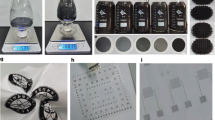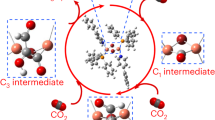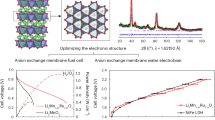Abstract
Platinum-based nanocatalysts play a crucial role in various electrocatalytic systems that are important for renewable, clean energy conversion, storage and utilization. However, the scarcity and high cost of Pt seriously limit the practical application of these catalysts. Decorating Pt catalysts with other transition metals offers an effective pathway to tailor their catalytic properties, but often at the sacrifice of the electrochemical active surface area (ECSA). Here we report a single-atom tailoring strategy to boost the activity of Pt nanocatalysts with minimal loss in surface active sites. By starting with PtNi alloy nanowires and using a partial electrochemical dealloying approach, we create single-nickel-atom-modified Pt nanowires with an optimum combination of specific activity and ECSA for the hydrogen evolution, methanol oxidation and ethanol oxidation reactions. The single-atom tailoring approach offers an effective strategy to optimize the activity of surface Pt atoms and enhance the mass activity for diverse reactions, opening a general pathway to the design of highly efficient and durable precious metal-based catalysts.
This is a preview of subscription content, access via your institution
Access options
Access Nature and 54 other Nature Portfolio journals
Get Nature+, our best-value online-access subscription
$29.99 / 30 days
cancel any time
Subscribe to this journal
Receive 12 digital issues and online access to articles
$119.00 per year
only $9.92 per issue
Buy this article
- Purchase on Springer Link
- Instant access to full article PDF
Prices may be subject to local taxes which are calculated during checkout





Similar content being viewed by others
Data availability
The data that support the findings of this study are available from the corresponding authors on reasonable request.
References
Yin, H. et al. Ultrathin platinum nanowires grown on single-layered nickel hydroxide with high hydrogen evolution activity. Nat. Commun. 6, 6430 (2015).
Wang, P. et al. Precise tuning in platinum–nickel/nickel sulfide interface nanowires for synergistic hydrogen evolution catalysis. Nat. Commun. 8, 14580 (2017).
Cao, Z. et al. Platinum–nickel alloy excavated nano-multipods with hexagonal close-packed structure and superior activity towards hydrogen evolution reaction. Nat. Commun. 8, 15131 (2017).
Huang, W. et al. Highly active and durable methanol oxidation electrocatalyst based on the synergy of platinum–nickel hydroxide–graphene. Nat. Commun. 6, 10035 (2015).
Ren, F. et al. One-pot synthesis of a RGO-supported ultrafine ternary PtAuRu catalyst with high electrocatalytic activity towards methanol oxidation in alkaline medium. J. Mater. Chem. A 1, 7255–7261 (2013).
Feng, Y.-Y., Bi, L.-X., Liu, Z.-H., Kong, D.-S. & Yu, Z.-Y. Significantly enhanced electrocatalytic activity for methanol electro-oxidation on Ag oxide-promoted PtAg/C catalysts in alkaline electrolyte. J. Catal. 290, 18–25 (2012).
Wu, H., Li, H., Zhai, Y., Xu, X. & Jin, Y. Facile synthesis of free‐standing Pd‐based nanomembranes with enhanced catalytic performance for methanol/ethanol oxidation. Adv. Mater. 24, 1594–1597 (2012).
Ren, F. et al. Clean method for the synthesis of reduced graphene oxide-supported PtPd alloys with high electrocatalytic activity for ethanol oxidation in alkaline medium. ACS Appl. Mater. Interfaces 6, 3607–3614 (2014).
Danilovic, N. et al. Enhancing the alkaline hydrogen evolution reaction activity through the bifunctionality of Ni(OH)2/metal catalysts. Angew. Chem. Int. Ed. 124, 12663–12666 (2012).
Li, M. et al. Ultrafine jagged platinum nanowires enable ultrahigh mass activity for the oxygen reduction reaction. Science 354, 1414–1419 (2016).
Chen, C. et al. Highly crystalline multimetallic nanoframes with three-dimensional electrocatalytic surfaces. Science 343, 1339–1343 (2014).
Choi, S.-I. et al. Synthesis and characterization of 9 nm Pt–Ni octahedra with a record high activity of 3.3 A/mgPt for the oxygen reduction reaction. Nano Lett. 13, 3420–3425 (2013).
Zhang, Z. et al. Crystal phase and architecture engineering of lotus–thalamus‐shaped Pt–Ni anisotropic superstructures for highly efficient electrochemical hydrogen evolution. Adv. Mater. 30, 1801741 (2018).
Zhang, Z. et al. One‐pot synthesis of highly anisotropic five‐fold‐twinned PtCu nanoframes used as a bifunctional electrocatalyst for oxygen reduction and methanol oxidation. Adv. Mater. 28, 8712–8717 (2016).
Zhang, L. et al. Platinum-based nanocages with subnanometer-thick walls and well-defined, controllable facets. Science 349, 412–416 (2015).
van der Vliet, D. F. et al. Unique electrochemical adsorption properties of Pt-skin surfaces. Angew. Chem. Int. Ed. 124, 3193–3196 (2012).
Cui, C., Gan, L., Heggen, M., Rudi, S. & Strasser, P. Compositional segregation in shaped Pt alloy nanoparticles and their structural behaviour during electrocatalysis. Nat. Mater. 12, 765–771 (2013).
Zhang, J. et al. Platinum monolayer on nonnoble metal–noble metal core–shell nanoparticle electrocatalysts for O2 reduction. J. Phys. Chem. B 109, 22701–22704 (2005).
Fu, X.-Z., Liang, Y., Chen, S.-P., Lin, J.-D. & Liao, D.-W. Pt-rich shell coated Ni nanoparticles as catalysts for methanol electro-oxidation in alkaline media. Catal. Commun. 10, 1893–1897 (2009).
Calle-Vallejo, F. et al. Finding optimal surface sites on heterogeneous catalysts by counting nearest neighbors. Science 350, 185–189 (2015).
Calle-Vallejo, F. et al. Why conclusions from platinum model surfaces do not necessarily lead to enhanced nanoparticle catalysts for the oxygen reduction reaction. Chem. Sci. 8, 2283–2289 (2017).
Huang, X. et al. High-performance transition metal–doped Pt3Ni octahedra for oxygen reduction reaction. Science 348, 1230–1234 (2015).
Strasser, P. et al. Lattice-strain control of the activity in dealloyed core–shell fuel cell catalysts. Nat. Chem. 2, 454–460 (2010).
Cui, C. et al. Octahedral PtNi nanoparticle catalysts: exceptional oxygen reduction activity by tuning the alloy particle surface composition. Nano Lett. 12, 5885–5889 (2012).
Subbaraman, R. et al. Trends in activity for the water electrolyser reactions on 3D M(Ni,Co,Fe,Mn) hydr(oxy)oxide catalysts. Nat. Mater. 11, 550–557 (2012).
Jiang, Q., Jiang, L., Wang, S., Qi, J. & Sun, G. A highly active PtNi/C electrocatalyst for methanol electro-oxidation in alkaline media. Catal. Commun. 12, 67–70 (2010).
Subbaraman, R. et al. Enhancing hydrogen evolution activity in water splitting by tailoring Li+-Ni(OH)2–Pt interfaces. Science 334, 1256–1260 (2011).
Zhao, Z. et al. Surface-engineered PtNi-O nanostructure with record-high performance for electrocatalytic hydrogen evolution reaction. J. Am. Chem. Soc. 140, 9046–9050 (2018).
Pearson, D., Ahn, C. & Fultz, B. White lines and d-electron occupancies for the 3d and 4d transition metals. Phys. Rev. B 47, 8471–8478 (1993).
Becknell, N. et al. Atomic structure of Pt3Ni nanoframe electrocatalysts by in situ X-ray absorption spectroscopy. J. Am. Chem. Soc. 137, 15817–15824 (2015).
Burke, M. S., Enman, L. J., Batchellor, A. S., Zou, S. & Boettcher, S. W. Oxygen evolution reaction electrocatalysis on transition metal oxides and (oxy)hydroxides: activity trends and design principles. Chem. Mater. 27, 7549–7558 (2015).
Bates, M. K., Jia, Q., Doan, H., Liang, W. & Mukerjee, S. Charge-transfer effects in Ni–Fe and Ni–Fe–Co mixed-metal oxides for the alkaline oxygen evolution reaction. ACS Catal. 6, 155–161 (2015).
Nørskov, J. K. et al. Trends in the exchange current for hydrogen evolution. J. Electrochem. Soc. 152, J23–J26 (2005).
Le Bacq, O. et al. Effect of atomic vacancies on the structure and the electrocatalytic activity of Pt‐rich/C nanoparticles: a combined experimental and density functional theory study. ChemCatChem 9, 2324–2338 (2017).
Chattot, Rl et al. Beyond strain and ligand effects: microstrain-induced enhancement of the oxygen reduction reaction kinetics on various PtNi/C nanostructures. ACS Catal. 7, 398–408 (2016).
Chattot, R. et al. Surface distortion as a unifying concept and descriptor in oxygen reduction reaction electrocatalysis. Nat. Mater. 17, 827–834 (2018).
Fei, H. et al. General synthesis and definitive structural identification of MN4C4 single-atom catalysts with tunable electrocatalytic activities. Nat. Catal. 1, 63–72 (2018).
Marcinkowski, M. D. et al. Pt/Cu single-atom alloys as coke-resistant catalysts for efficient C–H activation. Nat. Chem. 10, 325–332 (2018).
Back, S., Lim, J., Kim, N.-Y., Kim, Y.-H. & Jung, Y. Single-atom catalysts for CO2 electroreduction with significant activity and selectivity improvements. Chem. Sci. 8, 1090–1096 (2017).
Zhang, H., Liu, G., Shi, L. & Ye, J. Single‐atom catalysts: emerging multifunctional materials in heterogeneous catalysis. Adv. Energy Mater. 8, 1701343 (2018).
Kresse, G. & Hafner, J. Ab initio molecular dynamics for liquid metals. Phys. Rev. B 47, 558–561 (1993).
Kresse, G. & Hafner, J. Ab initio molecular-dynamics simulation of the liquid-metal–amorphous-semiconductor transition in germanium. Phys. Rev. B 49, 14251–14269 (1994).
Perdew, J. P., Burke, K. & Ernzerhof, M. Generalized gradient approximation made simple. Phys. Rev. Lett. 77, 3865–3868 (1996).
Hansen, M. H., Jin, C., Thygesen, K. S. & Rossmeisl, J. Finite bias calculations to model interface dipoles in electrochemical cells at the atomic scale. J. Phys. Chem. C 120, 13485–13491 (2016).
Acknowledgements
Y.H. acknowledges support from the Office of Naval Research (grant no. N000141812155). X.D. acknowledges financial support from the National Science Foundation (grant no. 1800580). T.C. was supported by the Collaborative Innovation Center of Suzhou Nano Science & Technology, the Priority Academic Program Development of Jiangsu Higher Education Institutions (PAPD) and the 111 Project. W.A.G. was supported by the Joint Center for Artificial Photosynthesis, a DOE Energy Innovation Hub, supported through the Office of Science of the US Department of Energy under award no. DE‐SC0004993. This work used the Extreme Science and Engineering Discovery Environment (XSEDE) which is supported by National Science Foundation grant no. ACI‐1053575. J.L. acknowledges the National Key R&D Program of China (2017YFA0700104) and National Natural Science Foundation of China (51761165012). STEM experiments were conducted using the facilities in the Irvine Materials Research Institute (IMRI) at the University of California-Irvine. The authors thank S. Fakra for technical support for the EXAFS experiment. This research used resources of the Advanced Light Source, which is a DOE Office of Science User Facility under contract no. DEAC02-05CH11231. R.Y. acknowledges the National Natural Science Foundation of China (51525102, 51390475). Use of resources of the National Center for Electron Microscopy in Beijing is acknowledged. The calculations were performed on the Hoffman2 cluster at UCLA Institute for Digital Research and Education (IDRE) and the Extreme Science and Engineering Discovery Environment (XSEDE), which is supported by the National Science Foundation (grant no. ACI‐1053575).
Author information
Authors and Affiliations
Contributions
X.D., Y.H. and P.S. supervised the project and designed the research. X.D., Y.H. and M.L. conceived the idea. M.L. and C.W. performed the synthesis, electrochemical tests and characterizations. K.D. and P.S. conceived and performed the DFT calculations. T.C. and W.G. performed the model simulations. L.Z. and W.C. performed XAS measurements and analysis. J.G. and W.C. provided expertise for XAS analysis. S.D. and X.P. performed the EELS and HAADF-STEM measurements. Z.Z., Y.Z., R.Y., J.L., K.Z. and Z.L. assisted with material characterizations. Z.Z., P.L., H.F., M.D., J.H. and H.S. assisted with catalytic measurements. M.L., K.D., C.W., P.S., Y.H. and X.D. co-wrote the paper. All authors discussed the results and commented on the manuscript.
Corresponding authors
Ethics declarations
Competing interests
The authors declare no competing interests.
Additional information
Publisher’s note: Springer Nature remains neutral with regard to jurisdictional claims in published maps and institutional affiliations.
Supplementary information
Supplementary information
Supplementary Figs. 1–11 and Supplementary Tables 1–4.
Supplementary Data
Atomic coordinates of the optimized computational models.
Rights and permissions
About this article
Cite this article
Li, M., Duanmu, K., Wan, C. et al. Single-atom tailoring of platinum nanocatalysts for high-performance multifunctional electrocatalysis. Nat Catal 2, 495–503 (2019). https://doi.org/10.1038/s41929-019-0279-6
Received:
Accepted:
Published:
Issue Date:
DOI: https://doi.org/10.1038/s41929-019-0279-6
This article is cited by
-
Single-atom Mo-tailored high-entropy-alloy ultrathin nanosheets with intrinsic tensile strain enhance electrocatalysis
Nature Communications (2024)
-
Pt, Ag and Au Nanoparticles on Hollow Carbon Spheres as Cathode ORR
Electronic Materials Letters (2024)
-
Surface engineering of 1-D nanocatalysts for value-added selective electrooxidation of organic chemicals
Nano Research (2024)
-
Long-range Pt-Ni dual sites boost hydrogen evolution through optimizing the adsorption configuration
Nano Research (2024)
-
Recent developments in noble metal–based hybrid electrocatalysts for overall water splitting
Ionics (2024)



